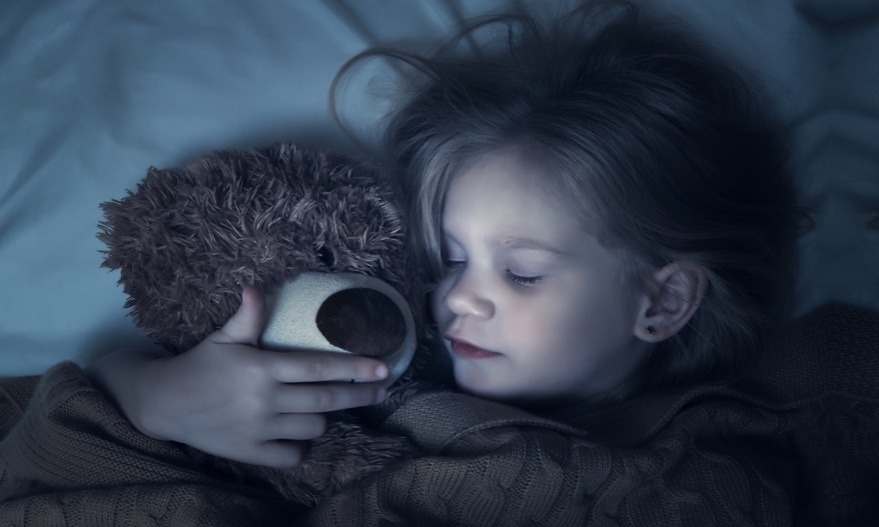Sleeping Problems in Children –
What Can You Do to Help?
Mindd Foundation

Sleeping problems in children occur far too often.
Sleep deprivation affects everyone negatively. However, when children don’t sleep, other family members don’t sleep.
In this article, Dr Leila Masson shares strategies that contribute to good sleep patterns and good health in children.
Dr Masson has extensive experience as an integrative paediatrician with a special interest in nutritional and environmental medicine.
Unfortunately, it can be common for children to be bright-eyed and rearing to go late at night. Even those without sleep disorders, or other conditions like autism or ADHD (that are often associated with bedtime issues), can suffer sleep disturbances.
Approximately 40% of children and young adults experience sleeping problems at some point in their lives.
The Effects of Children’s Sleeping Problems
A lack of sleep or sleep quality can be detrimental to a child’s mental and physical health. Research has shown that acute and persistent sleep deprivation is associated with poor memory and attention and may increase the risk of anxiety, encourage poor food choices and cause weight gain.1,2,3,4
While this is a cause for concern, parents can rest assured that many strategies can improve sleep habits. Whatever parents can do to encourage better sleeping habits is valuable for their children’s health and essential for their sanity.
How Much Sleep Do Kids Need?
Every child is different when it comes to sleep requirements. In fact, there is a current debate about how much sleep even adults need with the Australian Centre for Education stating there is no ‘magic number,’ while the American Academy of Sleep Medicine (AASM) and the Sleep Research Society (SRS) issued a new recommendation of 7 hours per night for adults.
For children, the range of hours needed varies depending on their age and situation. The Sleep Health Foundation provides a chart of the recommended sleep times for all age groups.
Solutions for Overcoming Sleeping Problems
and Encouraging Healthy Sleep Habits
Having a set routine before bed is essential for sleep promotion.
Earlier bedtimes, getting to sleep quicker, less night waking and more extended periods of sleep have all been linked to a consistent routine before bed.5
A routine reduces stress for both child and parent, with research showing a disorganized family may increase sleep disturbances and anxiety in children.1
- Setting times for each pre-bed activity can help (e.g., 7 pm bath, 7.30 pm quiet play or reading, 8:00 pm lights out).
- This means you know precisely when each activity begins and ends and you can relax in between those times.
- Write the schedule down or give your child a visual timetable by providing pictures of each activity in the correct order.
- Make sure you give your child a five-minute warning before the next activity to reduce the stress that may come with activity changes.
- Also, be flexible and work with your child to create the routine so the child is part of the process, which will lead to better compliance.
Dim the Lights
- Melatonin is the darkness hormone produced within our brains and is a necessary part of our daily or circadian rhythm. Once our eyes view the darkness of night and our brain clicks over to night-time, melatonin is produced. This lowers our body temperature and blood pressure, preparing us for sleep.6,7
- It is common for people to turn the lights on and close the blinds as soon as the sun sets and many children play or read in brightly lit rooms in the evening. Both of these can suppress the production of melatonin and cause sleeping problems.
- Maximising exposure to the natural cycles of daylight and darkness and minimizing exposure to bright artificial lighting can help with sleep patterns and thereby alleviate sleeping problems.
Minimise Blue Lights and Electronic Devices Before Bed
-

Screentime at night affects melatonin production
Blue light waves that are emitted from light globes and electronic devices are also a problem.
Electric light bulbs used these days, especially the Cool White, Daylight White Fluorescent, Energy-Saving Compact Fluorescent as well as LED bulbs, emit blue spectrum wavelengths (think of the blue sky of daylight). They suppress melatonin, mainly when used one hour before bed, increasing alertness and disrupting sleep. - In contrast, light sources with orange and red spectrum wavelengths (like candles) are beneficial for melatonin production. Changing your bedroom ceiling lights or lamps to orange or red globes may be helpful.
- It is also a good idea to wean your child off night-lights as any globes emitting blue wavelengths can affect melatonin production, even when your eyes are closed.
- Electronic devices also emit blue wavelength light, so it is best to stop using these and remove any from the bedroom, at night.7
Keep the Room and Body Temperature Low
Even our ancestors seemed to use the environmental temperature more than lighting for their sleep timing and duration.8 Our body temperature naturally drops at night so keeping it cool is best. The US National Sleep Foundation recommends a bedroom temperature of 18.3oC (65F).
Physical excitement, vigorous exercise, hot rooms and hot baths or showers (warm is okay) one hour before bed will increase the body’s temperature. This can stimulate the active part of our nervous system (called the sympathetic nervous system) to release stress hormones. It’s what prepares us for ‘flight or fight’ to be ready to deal with a perceived threat. This is not a good state to be in when trying to get to sleep.
In contrast, you can activate the calm part of the nervous system (called the parasympathetic nervous system) to put the body into a more relaxed mood through diaphragmatic breathing and progressive muscle relaxation.
Have your child close their eyes and breathe slowly through their nose, then gently breathe out through pursed lips, like they are gently blowing a giant bubble. Or talk them through a relaxation body scan where starting with their feet or legs, ask them to tense the body part and then relax, making the muscles soft and floppy. Work up the body.
Limit Eating and Caffeine Before Bed
- The general rule is to limit food 2-3 hours before bed.
- To avoid night-time snacking, try to ensure dinner is not given too early and contains a balance of protein, carbohydrates, and good fats, so the child is satisfied.
- Foods containing sugar and caffeine are best avoided at all times but especially from 3 pm onwards.
Look After The Gut to Avoid Sleeping Problems
The health of the intestinal bacteria (your microbiota) has been linked to sleep and behavior disorders.9 If your child has any digestive complaints, behavioral or anxiety-based issues, a functional stool test may provide some understanding of the problem and a probiotic supplement may be worthwhile. These tests are available through a functional medicine/biomedical or naturopathic health care professional (visit the Mindd Practitioner Directory to find one near you).
Other Beneficial Strategies for Sleep Promotion
These strategies may also help your child to sleep:
- Sing to your child (an old-fashioned lullaby can work a charm)
- Play relaxing, meditative music
- Give a pressure massage (especially helpful for those with sensory processing issues, which have been linked to sleep problems10).
- Add 2-3 cups of Epsom salts to a full warm bath. This provides the calming mineral, magnesium.
- Offer chamomile tea, cooled, during the pre-bed routine.
- If your child is a worrier, make sure you spend some time early in the day to discuss and ally their worries.
- Educate your child with books and apps on sleep
- Visit a health care professional who may advise magnesium, GABA (to encourage sleep and relaxation) or flower essences and homeopathic remedies (which may help with emotional issues).
In very persistent insomnia, a health professional may prescribe melatonin supplementation.
Finally, if your child has a specific neurological or developmental condition, seek out information from trained integrative healthcare professionals on strategies specific to that condition. Your child may also be a candidate for a sleep study to check for conditions such as sleep apnoea.
 Dr Leila Masson, Integrative Paediatrician
Dr Leila Masson, Integrative Paediatrician
Dr Masson is a Sydney-based integrative paediatrician with a special interest in nutritional and environmental medicine. Author of the excellent book ‘Children’s Health A to Z’ guide for parents.
Dr Leila Masson received her medical doctorate from the University of Berlin, did her paediatric specialist training at the University of California at San Francisco and received her Masters in Public Health from Harvard University.
Resources
- Sleep Associations/Centres/Foundations
- http://www.sleepeducation.org/
- https://sleepfoundation.org/
- http://www.sleepforkids.org/
- http://www.sleepcouncil.org.uk/
- http://www.sleepeducation.net.au/
- http://www.sleep.org.au/
- http://www.sleephealthfoundation.org.au/
- Sleeping apps to help children and parents
- http://www.sleepeducation.org/news/2013/10/14/fun-free-apps-help-children-learn-about-sleep
- http://kidssleepdr.com/ – produced by the Evelina Children’s Hospital in London
- http://www.parents.com/toddlers-preschoolers/sleep/schedule/best-sleep-apps/
- Progressive muscle relaxation script
- http://childrenwithanxiety.com/how-to-teach-children-progressive-muscle-relaxation.html
References
- Willis TA, Gregory AM. Anxiety disorders and sleep in children and adolescents. Sleep Med Clin. 2015;10(2):125-31.
- Goldman-Mellor S, Caspi A, Gregory AM, et al. Is insomnia associated with deficits in neuropsychological functioning? Evidence from a population-based study. Sleep. 2015;38(4):623-31.
- Amigo-Vazquez I, Busto-Zapico R, Pena-Suarez E, et al. [the influence of sleep and emotional states on childhood body mass index]. An Pediatr (Barc). 2015;82(2):83-8.
- Franckle RL, Falbe J, Gortmaker S, et al. Insufficient sleep among elementary and middle school students is linked with elevated soda consumption and other unhealthy dietary behaviors. Prev Med. 2015;74:36-41.
- Mindell JA, Li AM, Sadeh A, et al. Bedtime routines for young children: A dose-dependent association with sleep outcomes. Sleep. 2015;38(5):717-22.
- Trivedi AK, Kumar V. Melatonin: An internal signal for daily and seasonal timing. Indian J Exp Biol. 2014;52(5):425-37.
- Smolensky MH, Sackett-Lundeen LL, Portaluppi F. Nocturnal light pollution and underexposure to daytime sunlight: Complementary mechanisms of circadian disruption and related diseases. Chronobiol Int. 2015:1-20.
- Yetish G, Kaplan H, Gurven M, et al. Natural sleep and its seasonal variations in three pre-industrial societies. Current Biology. 2015.
- Burokas A, Moloney RD, Dinan TG, et al. Microbiota regulation of the mammalian gut-brain axis. Adv Appl Microbiol. 2015;91:1-62.
- Vasak M, Williamson J, Garden J, et al. Sensory processing and sleep in typically developing infants and toddlers. American Journal of Occupational Therapy. 2015;69(4):1-8 p.




